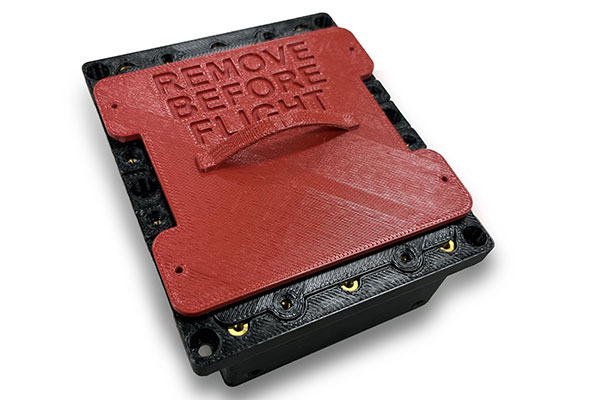Stratasys to Test Material Performance on Moon
To date, ground tests appear to show 50% radiation dose reduction, Stratasys reports.

FDM Antero 840CN03 radiation experiment housing with red UTLEM 9085 cover to protect test samples during transport. Image courtesy of Business Wire.
Latest News
March 13, 2024
Stratasys will provide 3D-printed materials for an upcoming lunar mission to test their performance on the surface of the moon. The experiments are part of Aegis Aerospace’s first Space Science & Technology Evaluation Facility mission (SSTEF-1). SSTEF is a commercial space testing service, developed by Aegis Aerospace in Houston, TX, under NASA’s Tipping Point program, to provide R&D services on the lunar surface.
The SSTEF-1 project focuses on technology development for space infrastructure and capabilities for the moon and near-earth space. The Stratasys experiments are sponsored by Northrop Grumman.
In this moon mission, Stratasys will provide 3D printed samples that will be brought to the lunar surface by an unmanned lander in a carrier structure 3D-printed by Stratasys. Three materials will be the focus of two different experiments led by Northrop Grumman.
The first experiment assesses the performance of a sample coupon part made with Stratasys’ Antero 800NA FDM filament filled with tungsten. Antero 800NA PEKK-based thermoplastic has mechanical properties, chemical resistance and low outgassing characteristics. Adding tungsten is intended to provide shielding against radiation such as gamma rays or x-rays.
The second passive experiment is designed to see how 3D-printed materials perform in space. It will include Antero 840CN03 FDM filament, which features ESD properties for use with electronics. The experiment will also include a new ESD photopolymer manufactured by Stratasys partner Henkel designed for high-heat environments. This experiment will subject coupon samples of the 3D-printed materials to moon dust, low pressure that can lead to outgassing, and the rapid temperature swings that result from nearly no atmosphere on the moon.
“Additive manufacturing is an important technology for space missions where every ounce of weight matters and high performance is essential,” says Chief Industrial Business Officer Rich Garrity. “This set of experiments will help us understand how to fully leverage 3D printing to keep people and equipment safe as we travel to the moon and beyond.”
Parts will be brought to the lunar surface by an unmanned lander in a Stratasys 3D printed carrier structure made from ULTEM 9085 thermoplastic, which is a material often used in commercial aircraft interiors.
Sources: Press materials received from the company and additional information gleaned from the company’s website.
More Stratasys Coverage
Subscribe to our FREE magazine, FREE email newsletters or both!
Latest News
About the Author
DE’s editors contribute news and new product announcements to Digital Engineering.
Press releases may be sent to them via [email protected].






